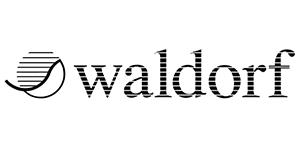
The respectable among professionals German brand was founded in 1988 thanks to Wolfgang Düren, a distributor of the famous synth maker of the 70-80s - Palm Products GmbH (PPG). Wolfgang Palm, the owner of the PPG, became renowned owing to the hit product of the 80s – Wave synthesizer (Wave 2, Wave 2.2, Wave 2.3 versions) which appeared to be the first synthesizers featuring physical modeling, wavetable synthesis. The sound they produced was so different from that of the other instruments due to its saturation feel and special coloring.
Technological designs made by Wolfgang Palm who was into electronic musical instruments developing are now actively used by Waldorf company where Palm works as a chief designer. The brand conquered the music world releasing revolutionary digital and virtual analog synthesizers, modules.
In 1989 the company released its first module called Microwave which quickly gained popularity. The series included the second issue of the module - Microwave II и Microwave XT. Microwave was the result of the technologies developed by PPG company combination. The complicated sound of the synthesizer, flexibility of timbral transitions is happening thanks to digital wave processing generated with wavetable synthesis, VCA and VCF – which is the actual basics of Waldorf sound, unrepeatable and irreplaceable by any rompler back then. The module allowed upgrading the firmware with the help of EPROM (Erasable Programmable Read Only Memory) improving its specification. In 1994 the company released an elaborated version Microwave I V2.0 which differed in increased memory. The second version of the analog module (Microwave II) has 4 controllers allowing sound tweaking in real time. The model got all the specs of its predecessor introduced and featured a nice display, improved modulation, new processing effects and multimode filters. Microwave XT in its turn appeared to be an enhanced model of Microwave II with a bigger number of voices (up to 30), increased number of knobs on the front panel. In 1999 a keyboard version was launched - Microwave XTk.
The instrument Wave by Waldorf was another step up from the used to be popular series designed by Wolfgang Palm. The instrument featured modular architecture. There were various keyboard versions released – 61, 76 keys with a 16-, 32- and 48-voice (expandable) polyphony. Wave sports intuitive interface with LCD, backlight and big number of control elements which makes it a favorite instrument in any professional musician’s collection.
Pulse series synthesizers included two versions of the instrument: Pulse and Pulse 2. The monophonic synthesizer is equipped with arpeggiator and three VCOs. The memory includes 100 presets 40 of which are user ones. The later version of the instrument has MIDI implemented and CV converter as well as an increased number of knobs and buttons to improve parameter control.
Q series synthesizers came out in 1999. The instrument featured analog sound based on physical modeling principle. It included a 16-voice polyphony expandable up to 32 voices. Each voice had 3 oscillators allotted with sync possibility, Q also had a built-in arpeggiator with user patterns, step sequencer and three LFOs. The synthesizer sports nice control thanks to comprehensive interface – display, control buttons, MIDI jacks as well as pedal jacks. In 2000 the compact version of the series instrument came out – microQ which comprised only 7 knobs to control sound and a 23-voice expandable polyphony. The model doesn’t incorporate step sequencer which makes it more affordable. The next model, an improved version called Q plus, introduced the architecture of Q and added 100 voices of polyphony and 16 new analog filters.
When geniuses and talented people who burn with an idea meet each other great deeds happen. One of such geniuses is Axel Hartmann – a German designer who was working for Waldorf in the 1990-2000s on Wave and Microwave products. Waldorf resorted to his designs for such instruments as Blofeld Desktop and, of course, the most vintage of all vintage electric pianos - Waldorf Zarenbourg (2006). Zarenbourg is a 33 kg orange (white or black) keyboard made of aluminum and featuring 7 factory presets/21 user presets based on frequency modulation, wide filter selection and built-in acoustics of the highest quality. This vintage unit producing super sounds will cost you $3000. You won’t be able to buy it easily and anywhere though it’s still available.
2007 was marked by Blofeld series module release which used virtual analog synthesis for sound generating, FM synthesis and wavetable synthesis. In 2009 a 49-key velocity sensitive version with aftertouch became available - Blofeld Keyboard. The instrument features 25 voices of polyphony and a 16-part multitimbrality, MIDI in/out as well as possibility of operating system update with the add-ons upload. The module and its keyboard version are put onto the market as affordable instruments featuring specification of their more expensive relatives – Q and Wave series. Anyway, those who want to get more for the same money can pay attention to the virtual analog synthesizer Studiologic Sledge which was also designed by Waldorf’s engineers.
The compact desktop modular synthesizer (2013) Waldorf Rocket offers analog synthesis with the MIDI control possibilities and virtual keyboard integration capability. The module has an extended interface to make the work with sound simpler as well as two knobs able to alter sound completely which makes the functioning easier for beginners. Streichfett – quite rare modular strings synthesizer – replicates the concept. The filter (12dB) enclosed into the similar housing.
In 2015 the company launched the interesting platform for professionals – KB37 (features a 3-octave keyboard for Eurorack modules) and Eurorack modules (double analog amplifier DVCA1, MOD1 modulator, NW1 wavetable synthesis module, CMP1 compressor) which can be applied to third-party systems as well as native platform.
Sound studios are equipped with Waldorf production all over the world: musicians have already approved the unique sound quality of the musical instruments. The brand’s exclusive technology is used in other companies’ production which tells about its real value for the music world.











